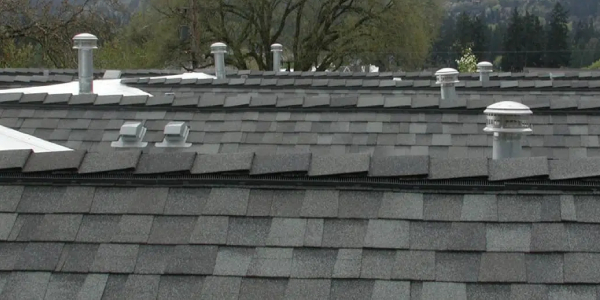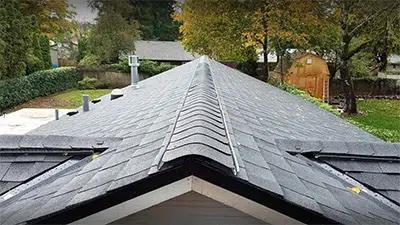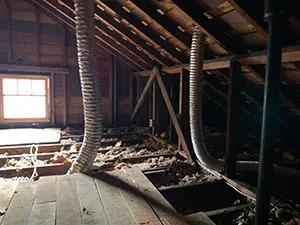Breathe easy with this guide to roof ventilation

By Pacific West Roofing.
Learn the ins and outs of how roof exhaust systems work, from vents to fans and more!
A proper ventilation system is key to having a safe and healthy roofing system, all year round. In the summer, when temperatures rise, it is important to have a way to let hot air escape from the roof. This keeps the environment in your home more comfortable, means you spend less money on air conditioning and keeps roofing materials from premature damage and decreasing their overall lifespan. In the winter, moisture can build up and when the heat is turned on, that moist air rises to the highest point of the home. If it doesn’t exit through a ventilation system, it can facilitate the growth of mold and mildew, which makes an unhealthy and uncomfortable living environment. The best way to avoid these problems is to ensure you have a properly installed and maintained roofing ventilation system. Learn how to make sure that your roof exhaust vents are functioning optimally from this expert guide built by Pacific West Roofing.

Types of roof exhaust vents
There are different types of roof exhaust vents:
- A box vent is a hole that is cut through the roof that has a box cover over the opening. Box vents are positioned near the roof peak for maximum exhaust ventilation.
- The ridge vent is a continuous strip of plastic material covering a strip of removed roof deck about one inch on both sides that allows continuous airflow due to convection. There must be an equal intake to output ratio in order for air to convect upwards and out of the building.
- A stem vent is used to connect your bathroom, kitchen or dryer fans to allow the moisture to escape properly and reduce moisture in the attic and in your home
All of these roof exhaust vents are non-powered or passive, working in tandem with soffit vents that sit at the lowest point of the roof to draw in outside air. The two types of vents together circulate the air keeping the heat and moisture to a minimum and your attic properly ventilated.
Power fan exhaust
In addition to roof exhaust vents, there are also attic exhaust fans. They work under the principle that hot air rises, but here instead of the hot air simply escaping through vents, it triggers an electric-powered fan to switch on to push the hot air outside. This creates a powerful suction drawing up the warm air and blowing it out through the roof. Removing heat in the attic stops the heat from radiating down into the house which then keeps the air conditioning unit from turning on, making it more efficient. While a very efficient solution for keeping a house comfortable, the fans are installed below the roof and can be quite heavy, so they cannot be installed on every type of roof.

Attic roof vents are similar to bathroom and kitchen roof vents in that they all suck “bad” air up and out of the house. However, bathroom and kitchen exhaust vents are smaller and powered by exhaust fans that you turn on when needed. Kitchen and bathroom vents can also be directed to release air through the home’s siding, not just the roof. Those metal protrusions you see on the sides or tops of houses are usually exhaust vents that have a type of protective covering to keep moisture and pests from getting inside.
Inspecting roof exhaust vents
Having roof vents is a critical part of keeping your roof in good shape and your home comfortable, but having them is just part of the solution. Regular inspections and maintenance of roof exhaust vents and ensuring they were installed correctly, are also part of the effort.
Contrary to popular belief, warm weather doesn’t produce moisture on nail heads, but cool weather outside and warm attics will. This is because the cold transfers through the steel nail, putting a cold rod into a warmer attic, creating a dew point where the warmer air carrying moisture meets the cold steel and condensation begins. This is the same as when you put a glass of ice water on the counter and it collects dew on the outside of the glass. The moisture in the room gravitates to the colder surface. This is exactly the same process on the nail in the attic.
The best way to ensure proper roof exhaust venting is to hire a professional roof contractor to conduct an inspection. Many roofing companies offer roof exhaust vent services starting with having expert inspectors assess your roof, attic and vents for signs of damage or blockage. Then repairs and replacements can be made to ensure your roof is sound and sufficiently ventilated. Hiring the best and most experienced professionals to install your roof exhaust vents in the first place can go a long way in keeping your roof, your home and the very air you breathe inside your home in tip-top shape.
Original article source: Pacific West Roofing
Have a question? AskARoofer.
Find your local roofing contractor in the RoofersCoffeeShop® Contractor Directory.











Comments
Leave a Reply
Have an account? Login to leave a comment!
Sign In